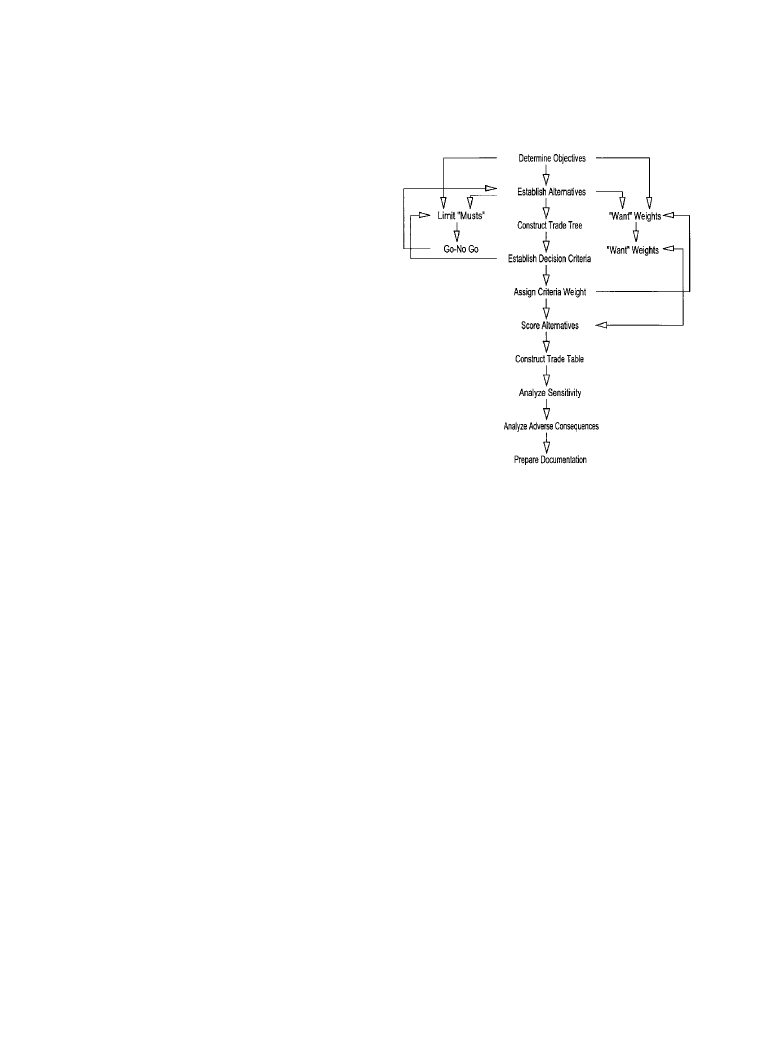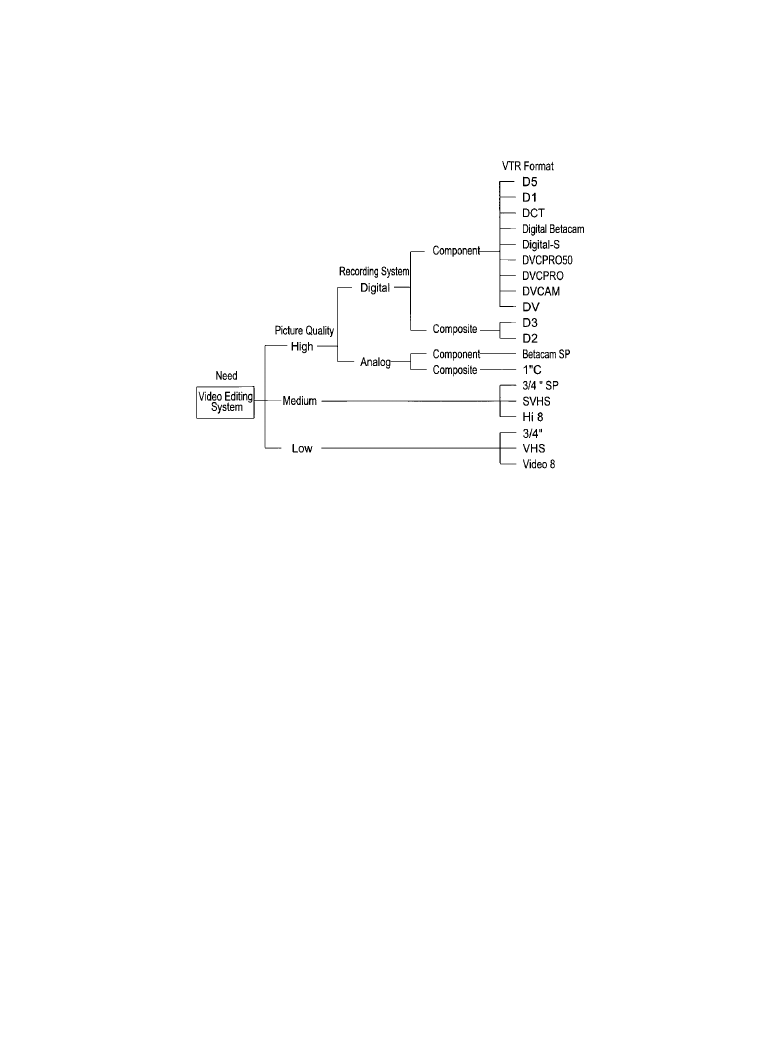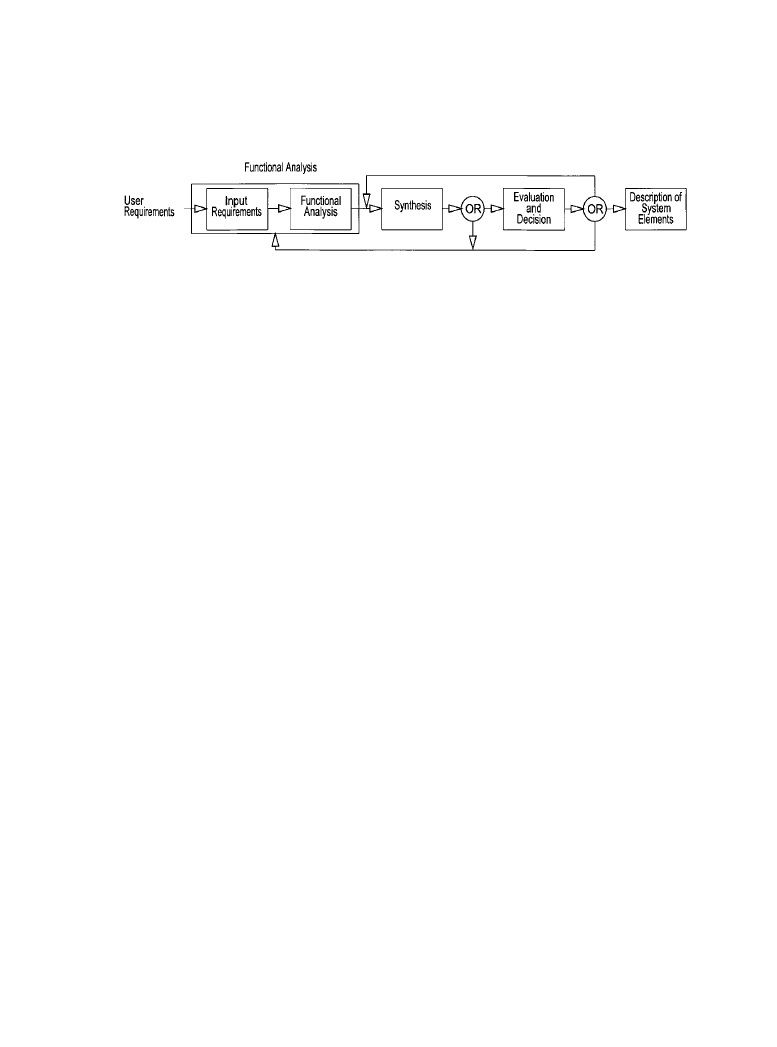ВУЗ: Казахская Национальная Академия Искусств им. Т. Жургенова
Категория: Книга
Дисциплина: Не указана
Добавлен: 03.02.2019
Просмотров: 21591
Скачиваний: 19

13-12 Standards and Practices
13.1.2h
Trade Studies
A structured approach is used in the trade study process to guide the selection of alternative con-
figurations and insure that a logical and unbiased choice is made. Throughout development,
trade studies are carried out to determine the best configuration that will meet the requirements
of the program. In the concept exploration and demonstration phases, trade studies help define
the system configuration. Trade studies are used as a detailed design analysis tool for individual
system elements in the full scale development phase. During production, trade studies are used to
select alternatives when it is determined that changes need to be made. Figure 13.1.4 illustrates
the relationship of the various of elements that can be employed in a trade study. To provide a
basis for the selection criteria, the objectives of the trade study must first be defined. Functional
flow diagrams and system block diagrams are used to identify trade study areas that can satisfy
certain requirements. Alternative approaches to achieving the defined objectives can then be
established.
Complex approaches can be broken down into several simpler areas and a decision tree con-
structed to show the relationship and dependences at each level of the selection process. This
trade tree, as it is called, is illustrated in figure 13.1.5. Several trade study areas may be identi-
fied as possible candidates for accomplishing a given function. A trade tree is constructed to
show relationships and the path through selected candidate trade areas at each level to arrive at a
solution.
Several alternatives may be candidates for solutions in a given area. The selected candidates
are then submitted to a systematic evaluation process intended to weed out unacceptable candi-
dates. Criteria are determined that are intended to reflect the desirable characteristics. Undesir-
able characteristics may also be included to aid in the evaluation process. Weights are assigned to
each criteria to reflect its value or impact on the selection process. This process is subjective. It
Figure 13.1.4
Trade study process flow.
(
After [2].)
Downloaded from Digital Engineering Library @ McGraw-Hill (www.digitalengineeringlibrary.com)
Copyright © 2004 The McGraw-Hill Companies. All rights reserved.
Any use is subject to the Terms of Use as given at the website.
Systems Engineering

Systems Engineering 13-13
should also take into account cost, schedule, and hardware availability restraints that may limit
the selection.
The criteria data on the candidates is collected and tabulated on a decision analysis work
sheet. The attributes and limitations are listed in the first column and the data for each candidate
listed in adjacent columns to the right. The performance data is available from vendor specifica-
tion sheets or can require laboratory testing and analysis to determine. Each attribute is given a
relative score from 1 to 10 based on its comparative performance relative to the other candidates.
Utility function graphs can be used to assign logical scores for each attribute. The utility curve
represents the advantage rating for a particular value of an attribute. A graph is made of ratings
on the y axis versus an attribute value on the x axis. Specific scores can then be applied that cor-
respond to particular performance values. The shape of the curve may take into account require-
ments, limitations, and any other factor that will influence its value regarding the particular
criteria being evaluated. The limits to which the curves should be extended should run from the
minimum value below which no further benefit will accrue to the maximum value above which
no further benefit will accrue.
The scores are filled in on the decision analysis work sheet and multiplied by the weights to
calculate the weighted score. The total of the weighted scores for each candidate then determines
their ranking. As a general rule, at least a 10 percent difference in score is acceptable as “mean-
ingful.”
Further analysis can be applied in terms of evaluating the sensitivity of the decision to
changes in the value of attributes, weights, subjective estimates, and cost. Scores should be
checked to see if changes in weights or scores would reverse the choice.
Figure 13.1.5
Trade tree example for a video project.
Downloaded from Digital Engineering Library @ McGraw-Hill (www.digitalengineeringlibrary.com)
Copyright © 2004 The McGraw-Hill Companies. All rights reserved.
Any use is subject to the Terms of Use as given at the website.
Systems Engineering

13-14 Standards and Practices
A trade table can be prepared to summarize the selection results. Pertinent criteria are listed
for each alternative solution. The alternatives may be described in a quantitative manner such as
high, medium, or low.
Finally, the results of the trade study are documented in the form of a report that discusses the
reasons for the selections and may include the trade tree and the trade table.
There has to be a formal system of change control throughout the systems engineering pro-
cess to prevent changes from being made without proper review and approval by all concerned
parties, and to keep all parties informed. Change control also insures that all documentation is
kept up to date and can help to eliminate redundant documents. Finally, change control helps to
control project costs.
13.1.2i
Description of System Elements
Five categories of interacting system elements can be defined: equipment (hardware), software,
facilities, personnel, and procedural data. Performance, design, and test requirements must be
specified and documented for equipment, components, and computer software elements of the
system. It is necessary to specify environmental and interface design requirements that are nec-
essary for proper functioning of system elements within a facility.
The documentation produced by the systems engineering process controls the evolutionary
development of the system. Figure 13.1.6 illustrates the process documentation used by one
organization in each step of the systems engineering effort.
The requirements are formalized in written specifications. In any organization, there should
be clear standards for producing specifications. This can help reduce the variability of technical
content and improve product quality as a result. It is also important to make the distinction here
that the product should not be over specified to the point of describing the design or making it
too costly. On the other hand, requirements should not be too general or so vague that the product
would fail to meet the customer needs. In large departmentalized organizations, commitment to
schedules can help assure that other members of the organization can coordinate their time.
The system engineering process does not actually design the system. The system engineering
process produces the documentation necessary to define, design, build, and test the system. The
technical integrity provided by this documentation ensures that the design requirements for the
system elements reflect the functional performance requirements, that all functional perfor-
Figure 13.1.6
Basic documentation for systems engineering. (
After [1].)
Downloaded from Digital Engineering Library @ McGraw-Hill (www.digitalengineeringlibrary.com)
Copyright © 2004 The McGraw-Hill Companies. All rights reserved.
Any use is subject to the Terms of Use as given at the website.
Systems Engineering

Systems Engineering 13-15
mance requirements are satisfied by the combined system elements, and that such requirements
are optimized with respect to system performance requirements and constraints.
13.1.3 Phases of a Typical System Design Project
The video industry has always been a very dynamic industry as a result of the rapid advancement
of electronic technology. The design of a complex modern video facility can be used to illustrate
the systems engineering approach.
13.1.3a
Design Development
System design is carried out in a series of steps that lead to an operational facility. Appropriate
research and preliminary design work is completed in the first phase of the project, the design
and development phase. It is the intent of this phase to fully delineate all requirements of the
project and to identify any constraints. Based on initial concepts and information, the design
requirements are modified until all concerned parties are satisfied and approval is given for the
final design work to proceed. The first objective of this phase is to answer the following ques-
tions.
•
What are the functional requirements of the product of this work?
•
What are the physical requirements of the product of this work?
•
What are the performance requirements of the product of this work?
•
Are there any constraints limiting design decisions?
•
Will existing equipment be used?
•
Is the existing equipment acceptable?
•
Will this be a new facility or a renovation?
•
Will this be a retrofit or upgrade to an existing system?
•
Will this be a stand alone system?
Working closely with the customer’s representatives, the equipment and functional require-
ments of each of the major technical areas of the facility are identified. In the case of facility ren-
ovation, the systems engineer's first order of business is to analyze existing equipment. A visit is
made to the site to gather detailed information about the existing facility. Usually confronted
with a mixture of acceptable and unacceptable equipment, the systems engineer must sort out
those pieces of equipment that meet current standards, and determine which items should be
replaced. Then, after soliciting input from the facility's technical and operational personnel, the
systems engineer develops a list of needed equipment.
One of the systems engineer's most important contributions is the ability to identify and meet
the needs of the customer, and do it within the project budget. Based on the customer's initial
concepts and any subsequent equipment utilization research conducted by the systems engineer,
the desired capabilities are identified as precisely as possible. Design parameters and objectives
are defined and reviewed. Functional efficiency is maximized to allow operation by a minimum
Downloaded from Digital Engineering Library @ McGraw-Hill (www.digitalengineeringlibrary.com)
Copyright © 2004 The McGraw-Hill Companies. All rights reserved.
Any use is subject to the Terms of Use as given at the website.
Systems Engineering

13-16 Standards and Practices
number of personnel. Future needs are also investigated at this time. Future technical systems
expansion is considered.
After the customer approves the equipment list, preliminary system plans are drawn up for
review and further development. If architectural drawings of the facility are available, they can
be used as a starting point for laying out an equipment floor plan. The systems engineer uses this
floor plan to be certain adequate space is provided for present and future equipment, as well as
adequate clearance for maintenance and convenient operation. Equipment identification is then
added to the architect's drawings.
Documentation should include, but not be limited to:
•
Equipment list with prices
•
Technical system functional block diagrams
•
Custom item descriptions
•
Rack and console elevations
•
Equipment floor plans
The preliminary drawings and other supporting documents are prepared to record design
decisions and to illustrate the design concepts to the customer. Renderings, scale models, or full
size mock ups may also be needed to better illustrate, clarify, or test design ideas.
Ideas and concepts have to be exchanged and understood by all concerned parties. Good com-
munication skills are essential for the team members. The bulk of the creative work is carried out
in the design development phase. The physical layout—the look and feel—and the functionality
of the facility will all have been decided and agreed upon by the completion of this phase of the
project. If the design concepts appear feasible, and the cost is within the anticipated budget, man-
agement can authorize work to proceed on the final detailed design.
13.1.3b
Electronic System Design
Performance standards and specifications have to be established up-front in a technical facility
project. These will determine the performance level of equipment that will be acceptable for use
in the system and affect the size of the budget. Signal quality, stability, reliability, and accuracy
are examples of the kinds of parameters that have to be specified. Access and processor speeds
are important parameters when dealing with computer driven products. The systems engineer
has to confirm weather selected equipment conforms to the standards.
At this point it must be determined what functions each component in the system will be
required to fulfill, and how each will function together with other components in the system. The
management and operation staff usually know what they would like the system to do, and how
they can best accomplish it. They have probably selected equipment that they think will do the
job. With a familiarity of the capabilities of different equipment, the systems engineer should be
able to contribute to this function-definition stage of the process. Questions that need to be
answered include:
•
What functions must be available to the operators?
•
What functions are secondary and therefore not necessary?
•
What level of automation should be required to perform a function?
Downloaded from Digital Engineering Library @ McGraw-Hill (www.digitalengineeringlibrary.com)
Copyright © 2004 The McGraw-Hill Companies. All rights reserved.
Any use is subject to the Terms of Use as given at the website.
Systems Engineering